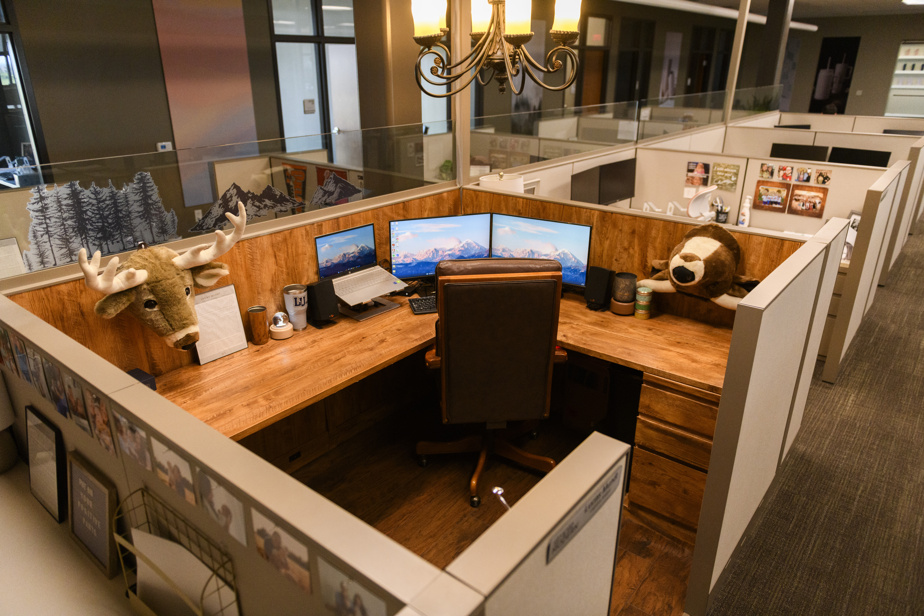Among office designers and architects, cubicles are rarely mentioned. This once-ubiquitous piece of equipment, so popular in the 1980s and 1990s, has been demonized as a sign of dehumanization of the workforce. Design experts now say cubicles are a “definite no.”
Yet cubicles are making a comeback, driven by demand from employers and employees.
“I honestly thought the market was dying,” says Brian Silverberg, who sells refurbished and used office furniture with his brother Mark at their Furniture X-Change store in North Brunswick, N.S. Jersey. “We have sold more cubicles in the last three years than in the previous five years,” he said, adding that 2024 would be “bigger than this year.”
COVID-19 has amplified a trend that predated the pandemic. According to Gensler’s Janet Pogue McLaurin, quiet spaces have become more important as workers return to the office after months of working from home. “We had seen a drop in efficiency due to sound interruptions, disruptions and a general lack of privacy,” she said.
Global demand has made cubicles and partitions a $6.3 billion market, which is expected to grow to $8.3 billion over the next five years, according to a 2022 report from Business Research Insights, a research firm. ‘market analysis.
Furniture makers had already recognized that workers wanted some privacy, despite employers’ tendency to value collaboration spaces more than individual workspaces.
Anyone who’s ever worked in an office with benches “hates open spaces,” says Michael Held, vice president of global design at furniture maker Steelcase.
Working from home during the pandemic has avoided the noise of coworkers, but it has also brought new distractions, including constant interruptions from family members and roommates, as well as the nagging temptation to do household chores . Employees cite lack of focus as the biggest problem with remote work, said Ryan Anderson, vice president of global research and insights at MillerKnoll, the furniture maker, who tracks worker trends with Boston Consulting Group and the Slack messaging platform.
Therefore, just as businesses try to juggle remote work and in-office mandates, they are also considering the right mix of collaborative spaces, conference rooms and individual spaces.
For example, at Grassi, a New York accounting and auditing firm with 500 employees, offices have been reconfigured into hybrid spaces, emphasizing cubicles or semi-private spaces as well as collaboration spaces open.
Some of the company’s seven offices were “too open, with no dedicated private space,” said Jeff Agranoff, director of human resources. Today the business has a combination of open and private spaces. (It also did away with scheduling reservations for desks, an arrangement known as hoteling. “Everyone has a reserved space,” says Mr. Agranoff, “because we were concerned that a significant number of desks would be reserved discourages employees from returning to the office.”)
Many employers now offer a variety of workspaces, including shared offices, conference rooms, phone booths and libraries, according to Ms. McLaurin. And, yes, cubicles.
But don’t expect to see six-foot-tall signs, because they’ve gone out of fashion. Instead, the new cubes offer what Held calls “seated privacy” with 54-inch-high panels.
Unlike the cubes featured in films like Office Space, which satirized their banal and sanitized appearance, the new cubes are ergonomic and flexible and can be equipped with lighting. They can be rectangular or rounded, with fixed or adjustable walls, and can accommodate several electronic devices.
Teams can adapt them to different needs, and some feature sound masking features. Steelcase, for example, has incorporated panels that absorb certain sound waves, creating “less echo in the space,” Mr. Held said, while reflecting less noise.
Standing desks are often integrated into new or renovated workstations. Some of the cabins redesigned by Grassi are equipped with glass walls. Arms can be attached to raise or lower the monitors to accommodate different heights as well as video calls.
Demand for refurbished desktops has declined from the peak of the pandemic, but still exceeds pre-pandemic levels. Trevor Langdon, CEO of Green Standards, a Toronto company that refurbishes and resells office furniture, says the increase in demand has been accompanied by a concomitant decline in the number of office benches. He adds that his inventory “suggests that our customers retain their low-panel workstations.”
After extended periods of working from home during the pandemic, manufacturers are recognizing the influence of residential design on office furniture. Some employees even go so far as to import their home decor into their workspace. Cubicle occupants often post photos to sites such as Pinterest and Instagram.
Lucas Mundt, a logistics analyst at Simple Modern in Oklahoma City, had already helped his coworkers hang pictures, but he wanted to transform his workspace into a faux-wood cabin. After getting permission, he got to work over a weekend when the office was empty. “I wanted to make it big,” he explains.
He added laminate wood floors and covered the walls with a wood-like adhesive paper. He added a photo of a window and, although he doesn’t hunt, two stuffed animals meant to replicate those often found in hunting lodges. The chandelier and the heater – which looks like a wood stove – are voice activated.
The transformation was unanimous in the office. Company CEO Mike Beckham was such a fan that he posted photos on social media and gave everyone in the office a $250 stipend — about the amount Mundt estimates he spent — to redecorate their offices.
Mr. Mundt acknowledged that his renovation was out of the ordinary. “If I’m going to spend 40 to 50 hours a week there, I wanted it to be comfortable and relaxing,” he said. And I feel at home in the mountains. »
